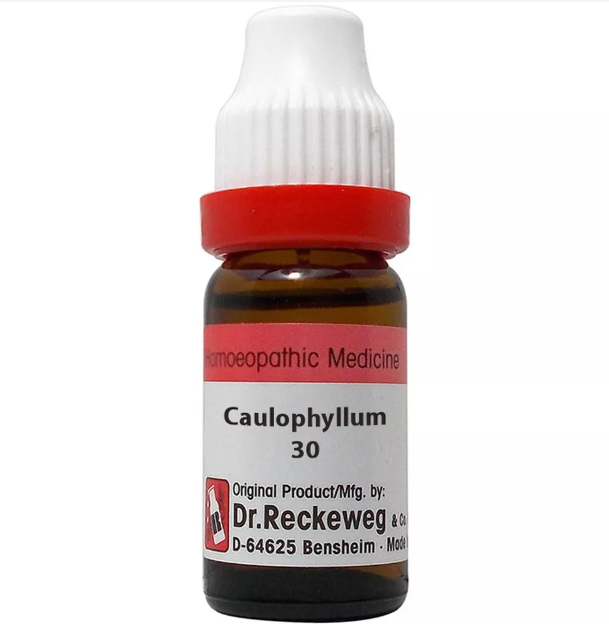CAULOPHYLLUM THALICTROIDES Q, 6C, 12C, 30C, 200C, 1M, 10M USES AND SYMPTOMS
 CAULOPHYLLUM THALICTROIDES
CAULOPHYLLUM THALICTROIDES
(Blue Cohosh)
This remedy for women, addressing a lack of uterine tone. It is useful during labor when contractions are weak, and the patient is tired and irritable. It also targets smaller joints, treating thrush both locally and internally.
Stomach: Addresses stomach spasms, heartburn, and dyspepsia with spasmodic symptoms.
Female: Treats extraordinary rigidity of the cervix (Bell., Gels., Verat-v.). Manages severe, spasmodic pains that radiate, shivering without labor progress, and false pains. Enhances labor pains and labor progress, relieves after-pains, and addresses leucorrhea with moth spots on the forehead. Useful for habitual abortion due to uterine weakness (Helon., Puls., Sabin.), needle-like cervical pains, dysmenorrhea with radiating pains, prolonged lochia, and atony. Manages profuse menses and leucorrhea.
Extremities: Alleviates severe drawing, erratic pain, and stiffness in small joints like fingers, toes, and ankles (rheumatism). Relieves aching in wrists and cutting pains when closing hands, with pains changing locations frequently.
Skin: Addresses skin discoloration in women with menstrual and uterine disorders.
Relationship: Incompatible with Coffea. Comparable to Viol-o. (rheumatic carpal and metacarpal joints); Cimic., Sep., Puls., Gels.
Dose: Tincture to third attenuation.
SYMPTOMS OF CAULOPHYLLUM THALICTROIDES
Stomach:
Stomach spasms
Heartburn (cardialgia)
Dyspepsia with spasmodic symptoms
Female:
Extraordinary rigidity of the cervix
Severe, spasmodic pains radiating to other areas
Shivering without labor progress
False labor pains
Weak labor contractions
After-pains following labor
Leucorrhea with moth spots on the forehead
Habitual abortion due to uterine weakness
Needle-like pains in the cervix
Dysmenorrhea with radiating pains
Prolonged lochia
Uterine atony
Profuse menstrual flow and leucorrhea
Extremities:
Severe drawing and erratic pain in small joints (fingers, toes, ankles)
Stiffness in small joints
Aching in wrists
Cutting pains on closing the hands
Pain that changes location frequently
Skin:
Discoloration in women with menstrual and uterine disorders
selection of the potency
Individualization:
- Homeopathy is based on the principle of treating the individual, not just the disease. The unique symptoms and characteristics of the person are crucial in determining the most suitable potency.
Intensity of Symptoms:
- The intensity of the symptoms guides the choice of potency. If the symptoms are intense and acute, a lower potency (e.g., 6C, 30C) might be considered. For chronic conditions with less intensity, higher potencies (e.g., 200C, 1M) may be appropriate.
Sensitivity of the Patient:
- Some individuals are more sensitive to homeopathic remedies, while others may require higher potencies. The practitioner considers the patient’s sensitivity when selecting the potency.
Acute vs. Chronic Conditions:
- Lower potencies are often used for acute conditions, while higher potencies may be considered for chronic or long-standing issues.
Previous Response to Potencies:
- The patient’s response to previous homeopathic treatments helps guide the choice of potency. If a particular potency has been effective in the past, it may be repeated or adjusted as needed.
Vital Force and Susceptibility:
- Homeopathy views illness as a disturbance in the vital force. The practitioner assesses the patient’s overall vitality and susceptibility to determine the appropriate potency.
Aggravation or Amelioration:
- The direction of the symptom response (aggravation or amelioration) after taking a remedy can influence the choice of potency.
Miasmatic Considerations:
- In classical homeopathy, the concept of miasms (inherited disease tendencies) is considered. The practitioner take this into account when selecting the potency.
Practitioner Experience:
- The experience and preference of the homeopathic practitioner play a role. Some practitioners may have success with certain potencies based on their clinical experience.
SAFETY INFORMATION
- Do not exceed the recommended dose by physician
- Keep out of the reach of children
- Store in a cool dry place away from direct sunlight
- Maintain half an hour gap between food/drink/any other medicines and homoeopathic medicine
- Avoid any strong smell in the mouth while taking medicine e.g. camphor, garlic, onion, coffee, hing
Medicine images use for reference only selection of homeopathic medicine depends on the individual’s specific symptoms and overall constitution. Moreover, homeopathy is a holistic system of medicine that treats the individual as a whole. In addition to addressing the physical symptoms, it takes into account the emotional and mental state of the person. Consequently, it’s crucial to consult with a qualified homeopathic practitioner for personalized treatment.
The information provided on this website is intended solely for educational purposes. Always seek the advice of your physician or other qualified health provider.
